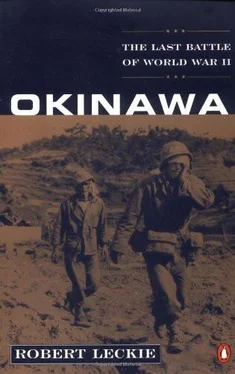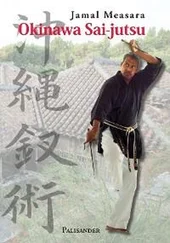These were the tactics that Lieutenant General Mitsuru Ushijima intended to employ on Okinawa with his defending Japanese Thirty-second Army. After his arrival there in August 1944, he hurled himself into the gratifying task of turning that slender long island into an ocean fortress. In January 1945, he sent his chief of staff, Lieutenant General Isamu Cho, to Tokyo for a review of his defenses. Imperial Headquarters planners were delighted with his preparations, for they dovetailed with Ten-Go. Ushijima’s monster ambush was just the tactic to lure the Americans within range of the suiciders—airborne and seaborne—to be smashed so shatteringly that the Thirty-second Army could take the offensive and destroy them.
Upon his return to Okinawa, Isamu Cho was a happy soldier, thirsting for battle and bursting to tell his chief the good news about Japan’s devastating new weapon of the Divine Wind.
The Japanese Samurai
CHAPTER FOUR
To understand the Samurai —a hereditary class of professional warriors peculiar to Japan—it is necessary to understand the history of Nippon. Up until 1853, when the American Commodore Matthew Perry opened Japan to world trade, Nippon had been a hermit kingdom into which no foreigner who valued his life would venture. True, between the founding of the Island Empire in 660 B.C. and the arrival of Perry, there had been a brief interlude of intercourse with the West. This occurred after a storm drove a China-bound Portuguese ship ashore in 1543. Later ships brought Catholic missionaries, among them Saint Francis Xavier, the great Jesuit missionary and a leader of the Catholic Counter-Reformation, who stepped ashore in 1549. Under his influence the population of a large area of the southern island of Kyushu became Catholic Christians. This pleased neither the ruling shoguns (military commanders in chief who had seized power from the emperor) or the Buddhist priests.
The shoguns quite understandably suspected that the Catholic missionaries might actually be advance scouts or spies for the colonizing Catholic powers of Europe. They remembered that after Spanish priests came to the Philippines with Ferdinand Magellan, they were followed by Spanish soldiers who made those islands the possessions of the king of Spain. An uprising of Kyushu Christians was put down with ferocious severity, and in 1617 a persecution of Christians was begun. All Christians, whether foreign or Japanese—Protestant or Catholic—were hunted down ruthlessly, and those who did not recant under torture were executed.
Thereafter Japan sank back into isolation. No one could leave the country under pain of death, and no foreigner enter under the same grim penalty. Nor were oceangoing ships allowed to be built. Every Japanese family was required to register at a Buddhist temple, and interest in Buddhist studies was encouraged. Shinto, the naive nature-and-ancestor worship of ancient Japan, was also revived. Shinto, a Chinese word (significant of Chinese influence on Japanese culture), was based on a simple feeling of reverence for any surprising or awesome phenomenon of nature: a waterfall, a splendid cloud formation, a mountain, a magnificent tree, or even an oddly shaped stone. Places that stimulated such delight or awe became Shinto shrines. At the head of this basically shamanist religion stood a master medicine man: the divine emperor.
Japanese tradition claimed that the imperial family was directly descended from the sun goddess. Actually, this family issued from the Yamato clan, which claimed the sun goddess as its progenitor. During the third and fourth centuries the Yamato clan’s priest-chiefs gained suzerainty and may be said to have unified the country, although without destroying the rights of the other clans. This ruling family, then, could claim an antiquity with which none of the other reigning families of the world could compare. It also could claim the allegiance of its subjects unto death itself. To fail or embarrass the emperor was a heinous, unforgivable crime for which there could be no penance or expiation other than self-destruction. This belief in the divinity of the emperor was cleverly and cynically exploited by the shoguns, who ruled the country through the emperor as figurehead.
The shoguns came to power after the imperial armies in the eighth century suffered setbacks at the hands of Japan’s original inhabitants, the Ainu—an extremely hairy race thereafter exiled to the inhospitable North by the heartless and frequently hairless Japanese, and called in contempt “the hairy Ainu.” Scorning the imperial conscripts, the shoguns formed their own smaller but better trained and disciplined armies. These were commanded by a new class of officers drawn from the sons of local clan chiefs and called Samurai. They formed this new hereditary class of professional warriors serving the daimyos, or feudal lords.
The Samurai were distinguished by their hair, shaven in front and top-knotted, and the clan badge worn on their kimonos. They lived Spartan lives and were rigidly drilled—from childhood to manhood—in self-control: a Samurai was taught to show “no joy or anger.” Nor was he ever to engage in trade or handle money. Like Christian seminarians, he had contempt for commerce as being infra dignitatem, beneath his dignity. He was also trained to excel in the martial arts. Indeed the two swords worn by the Samurai —one long and one short—were also badges of rank. Samurai were expected to become especially proficient with the long, two-handed sword, actually a thick, heavy, single-edged, and extremely sharp saber. The short one was for decapitating a fallen enemy or dispatching himself by seppuku, more commonly known as hara-kiri, literally, “stomach cutting.” To kill himself in atonement for failure or disgrace, a Samurai would squat on the floor and thrust his short sword into his stomach—turning it in a ceremonial disembowelment that, if it became unbearably painful, could be ended by a comrade standing by to strike his neck with a saber, severing the spinal column.
A lifetime of cultivating indifference to pain, however, was part of a Samurai ’s code of Bushido: “the way of the warrior.” With this inevitably arrogant warrior class, permitted to cut down any commoner “who has behaved to him in a manner other than he expected,” the shoguns ruled Japan. And their reign continued for more than two centuries after the extinction of Christianity. It ended only when Commodore Perry appeared in his steam-driven “black ships,” so terrifying to the insular Japanese when they saw these vessels without sails moving easily against the wind on Tokyo Bay. Very quickly a treaty opening two ports to the Americans was signed.
This unprecedented deference (not to say obeisance) to a foreign power so enraged conservatives of all callings—the merchants, daimyos, the Samurai —that it provoked a revolution known as the Meiji Restoration ending the power of the shoguns and restoring it to the emperor. It also culminated the career of the Samurai. No ruler could feel entirely safe with such dangerous zealots at large within his borders, and so by imperial edict these fierce warriors accepted the lump-sum termination offered them to hang up their swords and become merchants, lawyers, doctors, or bureaucrats. But they did not remain long suppressed, for the Meiji Restoration, in perhaps the most astonishing national turnabout in history, had embraced in one swoop the entire apparatus of the once-despised Western civilization. Everything invented or developed by the “Round Eyes” since Greece, Rome, and the advent of the Christian Era—their science, industry, culture, political institutions, methods of education, business practices, economics, dress, and even sports—was swallowed whole by Nippon.
Читать дальше










